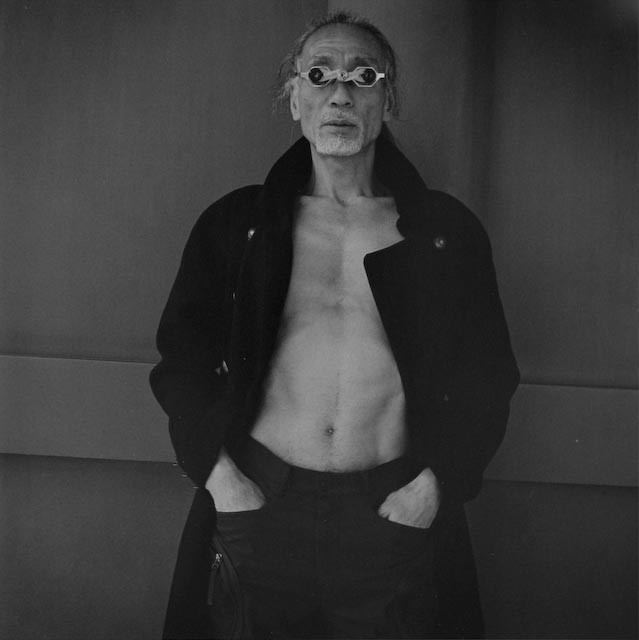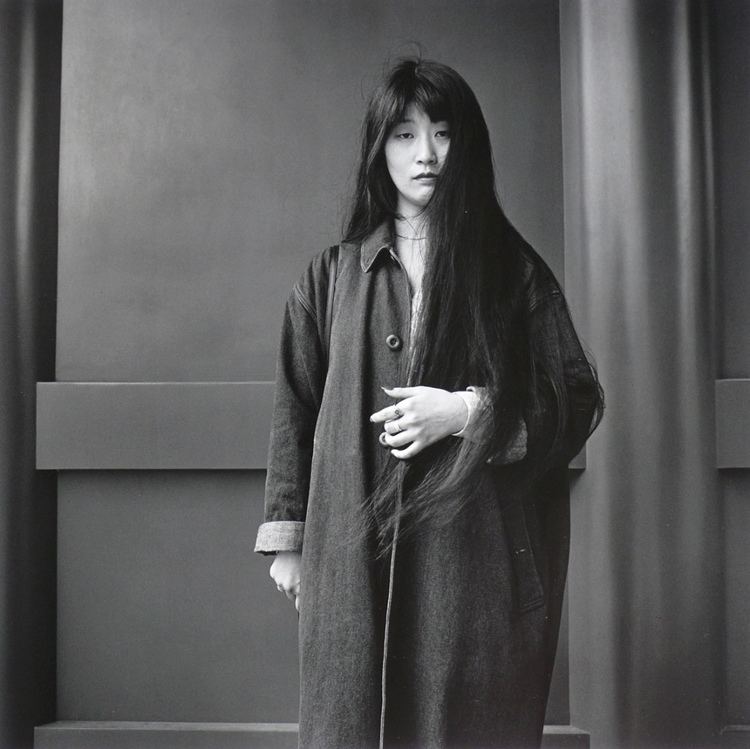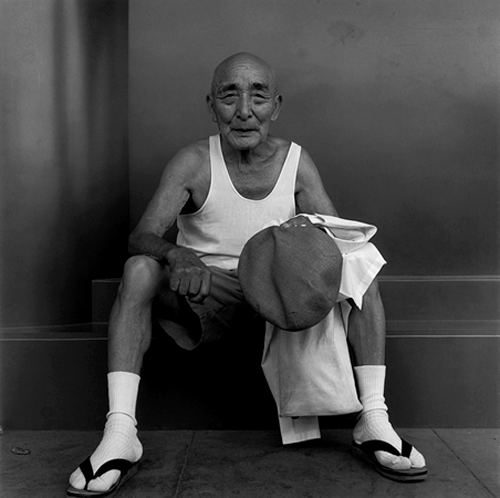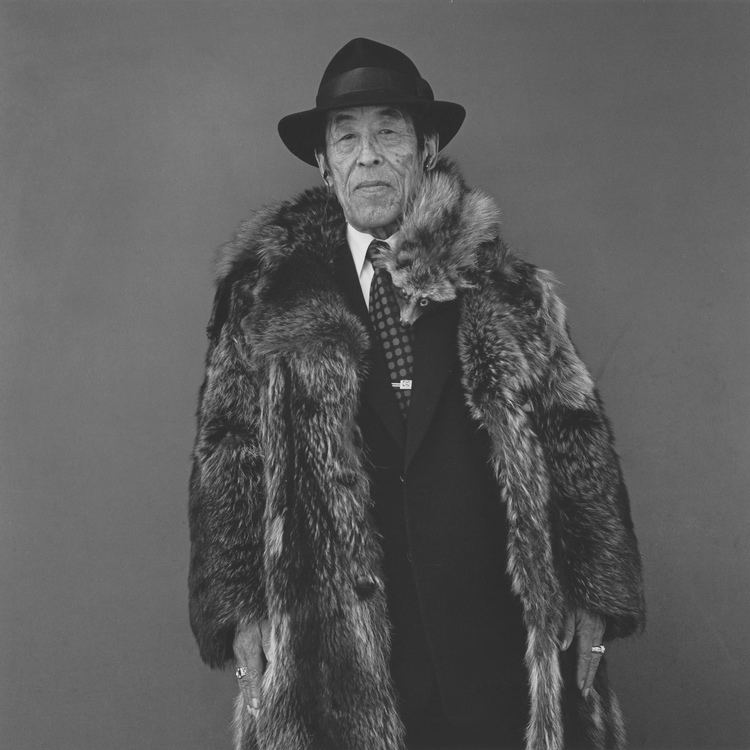Name Hiroh Kikai Role Photographer | Books Hiroh Kikai | |
 | ||
Portrait master hiroh kikai reviewing my photos
Hiroh Kikai (鬼海 弘雄, Kikai Hiroo, born 18 March 1945) is a Japanese photographer best known within Japan for four series of monochrome photographs: scenes of buildings in and close to Tokyo, portraits of people in the Asakusa area of Tokyo, and rural and town life in India and Turkey. He has pursued each of these for over two decades, and each has led to one or more book-length collections.
Contents
- Portrait master hiroh kikai reviewing my photos
- Early years
- Career
- Asakusa portraits
- Portraits of spaces
- India
- Turkey
- Photography elsewhere
- Writing
- Exhibitions
- Selected solo exhibitions
- Selected group exhibitions
- Permanent collections
- Books by Kikai
- Other books with contributions by Kikai
- References

Although previously a respected name in Japanese photography, Kikai was not widely known until 2003, when the first edition of his book Persona, a collection of Asakusa portraits, won both the Domon Ken Award and Annual Award of the PSJ. In 2009, the ICP and Steidl copublished Asakusa Portraits for an international market.

Early years

Kikai was born in the village of Daigo (now part of Sagae, Yamagata Prefecture) on 18 March 1945 as the seventh and last child (and fifth son) of the family. He had a happy childhood, from the age of 11 or so preferring to play by himself in the nature that surrounded the village. He graduated from high school in 1963 and worked in Yamagata for a year, and then went to Hosei University in Tokyo to study philosophy. As a student he was keen on the cinema — he particularly enjoyed the films of Andrzej Wajda, who would later contribute essays to some of his books, and Satyajit Ray — and has said that he would have worked in film production if it did not require writing, a task he has never enjoyed, and money, which he lacked.

Immediately after his graduation in 1968, Kikai worked for two years as a truck driver and for two in a shipyard. Meanwhile, he stayed in touch with his philosophy professor from his university days, Sadayoshi Fukuda, whose interests extended to writing a regular column for the magazine Camera Mainichi; he introduced Kikai to its editor, Shōji Yamagishi, who showed him photographs by Diane Arbus that made a great impact on Kikai. Kikai started to take photographs in 1969. At that time (when somebody fresh out of university could expect to earn ¥40,000 per month), a Hasselblad SLR camera normally cost ¥600,000; Kikai heard of an opportunity to buy one for ¥320,000 and mentioned this to Fukuda, who immediately lent him the money, with no interest, and no date or pressure for repayment. (The loan was eventually repaid.) This Hasselblad 500CM, with its 80 mm lens, is what Kikai has used for his portraits ever since.
Career

Kikai thought that work on a boat might be photogenic, but, having no experience, could not get a job on one. He was eventually accepted on a boat fishing for tuna when he displayed the scar from an unneeded appendectomy as evidence of one risk fewer that his presence might force the boat into port. He worked on the boat in the Pacific from 6 April until 9 November 1972, with a stop in Manzanillo (Mexico) for provisions. It was during this time that he took his first photographs to be published, in the May 1973 issue of Camera Mainichi. In 1973 he won a prize for his submission to the 14th exhibition of the Japan Advertising Photographers’ Association. But Kikai decided that in order to be a photographer he needed darkroom skills, and he returned to Tokyo to work at Doi Technical Photo (1973–76). He became a freelance photographer in 1984, a year after his first solo exhibition and the same year as his second.

Living close to Asakusa (Tokyo), Kikai often went there on his days off, taking photographs of visitors. He stepped up his visits in 1985; a number of collections of his portraits taken there have been published.
Kikai’s other long-term photographic projects are of working and residential neighborhoods in and near Tokyo, and of people and scenes in India and Turkey. All these are black and white. However, his occasional diversions have included color photographs of the Gotō Islands and even of nudes.
Unusually in Japan, where photographers tend to join or form groups, Kikai has never been in any group, preferring to work by himself. When not setting out to take photographs, Kikai does not carry a camera with him. He leaves photographing his own family to his wife Noriko, and it is she who has the camera if they go on a trip together.
In the early part of his career, Kikai often had to earn money in other ways: after three years’ work in the darkroom, he returned to manual labor.
Kikai taught for some time at Musashino Art University, but he was disappointed by the students’ lack of sustained effort and therefore quit.
Asakusa portraits
Kikai had started his Asakusa series of square, monochrome portraits as early as 1973, but after this there was a hiatus until 1985, when he realized that an ideal backdrop would be the plain red walls of Sensō-ji. At that time, the great majority of his Asakusa portraits adopted further constraints: the single subject stands directly in front of the camera (originally a Minolta Autocord TLR, later the Hasselblad), looking directly at it, and is shown from around the knees upwards. Kikai may wait at the temple for four or five hours, hoping to see somebody he wants to photograph, and three or four days may pass without a single photograph; but he may photograph three people in a single day, and he has photographed over six hundred people in this way. He believes that to have a plain backdrop and a direct confrontation with the subject allows the viewer to see the subject as a whole, and as somebody on whom time is marked, without any distracting or limiting specificity.
Though Kikai started to photograph in Asakusa simply because it was near where he then lived, he has continued because of the nature of the place and its visitors. Once a bustling and fashionable area, Asakusa long ago lost this status. If it were as popular and crowded as it was before the war, Kikai says, he would go somewhere else.
Published in 1987, Ōtachi no shōzō / Ecce Homo was the first collection of these portraits. It is a large-format book with portraits made in Asakusa in 1985–86. Kikai won the 1988 Newcomer’s Award of the Photographic Society of Japan (PSJ) for this book and the third Ina Nobuo Award for the accompanying exhibition.
In 1995, a number of portraits from the series were shown together with the works of eleven other photographers in Tokyo/City of Photos, one of a pair of opening exhibitions for the purpose-made building of the Tokyo Metropolitan Museum of Photography.
Ya-Chimata, published a year later, has a greater number of portraits printed more cheaply on smaller pages.
Persona (2003) is a further collection of portraits made in Asakusa. A few are from Kikai’s earliest work, but most postdate anything in the earlier books. Several of the subjects appear twice or more often, so the reader sees the effect of time. The book format is unusually large for a photograph collection in Japan, and the plates were printed via quadtone. The book won the 23rd Domon Ken Award and 2004 Annual Award of the PSJ. A smaller-format edition with additional photographs followed two years later.
Asakusa Portraits (2008) is a large collection edited by the International Center of Photography (New York), published in conjunction with the ICP’s exhibition of recent Japanese photography and art Heavy Light. Kikai’s contribution to this exhibition was well received, and Asakusa Portraits won praise for its photography and also (from Paul Smith) for the vernacular fashion of those photographed.
Portraits of spaces
Kikai has said that people and scenery are two sides of the same coin. When tired of waiting (or photographing) in Asakusa, he walks as far as 20 km looking for urban scenes of interest where he can make “portraits of spaces”. A day’s walk might take two or three hours for less than a single roll of 120 film. He generally photographs between 10 a.m. and 3 p.m., and avoids photographing when people are outside as their presence would transform the photographs into mere snapshots, easily understood; even without people, they are the images or reflections of life. Kikai may find a scene that he wants to photograph and then wait there and only photograph it when something unexpected occurs in the frame. After development, he does not bother with contact prints, instead judging a photograph by the negative alone.
Samples from this series have appeared in various magazines from at least as early as 1976. Each photograph is simply captioned with the approximate address (in Japanese script) and year.
Tōkyō meiro / Tokyo Labyrinth (1999) presents portraits of unpeopled spaces in Tokyo (and occasionally the adjacent town of Kawasaki). There are individual shopfronts, rows of shops and residential streets. Most of the buildings are unpretentious. Like the Asakusa series, these portraits are monochrome and square, taken via a standard lens on 120 film.
Tōkyō mutan / Labyrinthos (2007) — based on an essay/photograph series that ran in the monthly Sōshi (草思) from March 2004 to July 2005 and then in the web series “Tokyo Polka” — presents more of the same. Between a single nude in a shopfront display from 1978 and a very young boy photographed in December 2006 (the latter appearing to share the Sensō-ji backdrop of Persona), are square monochrome views of Tokyo and Kawasaki, compositions that seem casual and rather disorderly, mostly of unpeopled scenes showing signs of intensive and recent use. The book also has Kikai’s essays from “Tokyo Polka”, essays that dwell on the inhabitants of Tokyo as observed during walks or on the train.
Tokyo View (2016) is a large-format collection, mostly of photographs that also appear in one or other of the earlier books (or Tōkyō pōtoreito / Tokyo Portraits).
India
Kikai has said that going to India feels like a return to the Yamagata of his youth, and a release from life in Tokyo. His photography there is much less planned or formal than his portraits of people or places in Tokyo: after an early start with color 120 film, he uses black and white 35 mm film in India — and has laughingly said that he would use 35 mm in Tokyo if the city were more interesting and didn’t make him feel unhappy.
India, a large-format book published in 1992, presents photographs taken in India (and to a much lesser extent Bangladesh) over a period totalling rather more than a year and ranging from 1982 to 1990. It won high praise from the critic Kazuo Nishii, who commented that the India of Kikai’s work seems perpetually overcast, and that in their ambiguity his photographs seem to benefit from the work done in the Asakusa portrait series. The book won Kikai the 1993 Society of Photography Award.
Shiawase / Shanti (2001) is a collection of photographs that concentrates on children, most of which were taken in Allahabad, Benares, Calcutta, Puri and Delhi in 2000. It won the Grand Prix of the second Photo City Sagamihara Festival.
Turkey
Wanting to explore somewhere that (in contrast to India) was cold, as well as a Muslim land where Asian and European cultures meet, in 1994 Kikai made the first of six visits to Turkey, where he has stayed for a total of nine months. His monochrome photographs of Turkey appeared in the magazine Asahi Camera, and his colour photographs on its website, before the publication in January 2011 of his large book Anatolia, a compilation of his monochrome work.
Photography elsewhere
Kikai was one of thirteen Japanese photographers invited by EU–Japan Fest to photograph the twenty-six nations of the European Union; he spent twenty-one days in Malta in September 2005 and a short period in Portugal in October 2004, travelling widely in both countries. In color, these photographs are a departure from his earlier work. Most are more or less candid photographs of people. A collection was published as the eighth in a series of fourteen volumes, In-between.
Series of color photographs from short visits to Cuba (2007) and Taiwan (2013) have appeared in Asahi Camera.
Writing
Kikai's essays have appeared in periodicals and within some of his own photobooks. They have also been collected in four books, in which they are illustrated by reproductions of relevant photographs.
Indo ya Gassan (“India and Gassan”, 1999) is a collection about and photographs of India. Gassan is a mountain in central Yamagata close to where Kikai was brought up; Kikai muses on India and compares it with the Yamagata of his youth.
Me to kaze no kioku (“Memories of the eye and the wind”, 2012) collects essays published in Yamagata Shinbun (山形新聞) since 2006; Dare omo sukoshi suki ni naru hi: Memekuri bōbiroku (“Days when you come to like anyone a little: An image-turning aide-memoire”, 2015) collects essays published in Bungakukai (文學界) since 2011; Kutsuzoku no herikata (“Ways to wear down shoe rubber”, 2016) is a fourth collection.
Exhibitions
Supplementary English titles in parentheses are nonce translations for this article; those outside parentheses and in quotation marks were used at the time.
